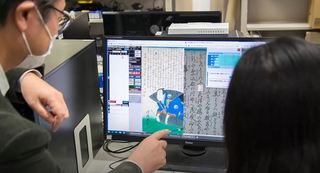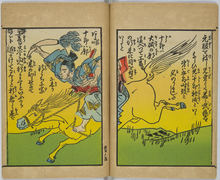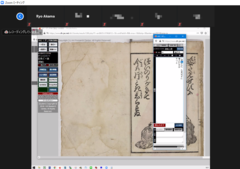-
An Interview with Prof. Ryo Akama--ARC Deputy Director--on the Kuzushiji Training Course to Decipher Japanese Cursive Script with the ARC Transcription Support SystemJune 25, 2021(Fri)
Background:
Kuzushiji is a kind of Japanese cursive script found in early Japanese books (until the mid-Meiji Period).
Due to the different writing styles compared with modern Japanese characters, kuzushiji can be understood only by a minority of trained specialists.
The Art Research Center (ARC), Ritsumeikan University, has developed an educational transcription system with an AI-enabled deciphering support function for kuzushiji to facilitate access to early Japanese books for academic research.
The training course started on May 14, 2021, and has counted participants from 12 countries so far. It is provided free of charge. (→Click here for details on the training course.)Professor Akama, thank you very much for your time today. You have just completed Phase 1 of the kuzushiji training course for beginners and intermediate levels. What is the purpose of your training course?
 Prof. Akama: We have developed an AI-enabled transcription support system for kuzushiji specifically for educational purposes as part of an industry-academia collaboration with Toppan Printing Co., Ltd. The company kindly provided us with the API (application programming interface) of their kuzushiji recognition system that is powered by deep learning.
Prof. Akama: We have developed an AI-enabled transcription support system for kuzushiji specifically for educational purposes as part of an industry-academia collaboration with Toppan Printing Co., Ltd. The company kindly provided us with the API (application programming interface) of their kuzushiji recognition system that is powered by deep learning.Our purpose is to teach and support students and researchers in utilizing our transcription support system for their academic research projects based on the abundant materials available in the ARC's Early Japanese Books Portal Database. You can freely choose the materials you wish to transcribe from our database--with over 218,000 titles, one of the largest databases of digital-archived early Japanese books in the world.
I have held several workshops on the system, for instance, at the University of Leiden and the University of California, Berkeley. Not able to travel due to the pandemic, I hope to promote the system's usage by offering this online training course.
Could you tell us about the significance of developing a transcription support system?

Prof. Akama: The Edo Period was peaceful and culturally mature--an ideal environment for commercial publishing and the distribution of woodblock-printed books to flourish as the literacy rate among the population was reasonably high.
Hence, books from a variety of genres written in kuzushiji were published during this time containing valuable information about art, culture, history, and more. However, only a fraction of them has been transcribed.
The transcription support system facilitates access to these books for students, researchers, and people in the fields related to Japanese arts and culture, to obtain a deeper understanding of the past as we strive to preserve cultural heritage.
What is the merit of the ARC Transcription Support System as compared with other transcription systems for kuzushiji?
Prof. Akama: The merit of our transcription support system lies in its educational function.
Our interactive system enables students to learn and practice transcribing and archiving digital texts of early Japanese books fast and efficiently.

It is particularly suited for being used in lectures and study groups under the supervision of an instructor or as part of individual or group research projects.
As the system offers a user-friendly interface with a vertical input window for transcriptions next to the original kuzushiji text, users can easily compare and check the contents as they proceed.
Should users encounter difficulties, the AI-enabled deciphering support function gives a list of suggestions ranked by percentage. If there is no suitable suggestion based on the context, users can search in our extensive Character Image Database or request support from the instructor.
Hence, users can gradually enhance their ability to read kuzushiji with clues provided by the system and the feedback given by instructors.
Could you tell us about your plans for the future regarding this system?
Prof. Akama: As we continue to utilize the system to advance the projects under our ARC-iJAC umbrella, we also warmly encourage international researchers, both individuals and groups, to →contact us should you be interested in using the system for your research or teaching.
Our system is a powerful tool to accelerate digital humanities research of Japanese art and culture, so I hope to expand its usage in lectures, study- and project groups in Japan and overseas.
Prof. Akama, thank you very much for your time today.
(This interview was conducted by Yinzi Emily Li.)













